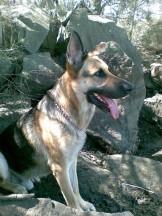THE PROGRAM
Our Dogs
 We primarily acquire our dogs from animals shelters and rescue groups. In this way we give dogs which, to little fault of their own, have been displaced and unwanted and a chance to full-fill their greatest desire which is to serve and please a human partner.
We primarily acquire our dogs from animals shelters and rescue groups. In this way we give dogs which, to little fault of their own, have been displaced and unwanted and a chance to full-fill their greatest desire which is to serve and please a human partner.
There are no particular breeds or an ideal size of dog that we look for. It is completely based on each dog’s individual personality and temperament. For the most part, we pick dogs between the ages of one to four years of age.
When we acquire a new dog, the first stage is to introduce him or her into a stable ‘canine pack’ environment. It is here that their old ways lose meaning and new expectations are learned, and at this time we get to know our new member better.
From this point a foster home is found and the individual training begins. These temporary homes may last anywhere from two months to up to a year. It is at this stage that the dog completes its obedience and socialization training. Our volunteers that open their home, share their family and other pets, with the aim of creating an Assistance Dog. This is a vital part of the program. Together we make ‘People Helping Dogs Help People’.
Your Dog
Our program also provides for people who would like to use their current (or future) pet to train and register as an Assistance Dog, whenever it is feasible and appropriate. Naturally there are assessments and requirements to enter an owner-trained dog into the program.
Training
All animals are learning throughout their entire life. Our method of training uses ‘natural’ learning: “classical conditioning”, “guided learning”, and “operant conditioning”, to maximize outcomes while keeping stress to a minimum. One of the methods used is known as “Clicker Training” (event marking) which has gained greater public recognition through marine mammal training.
All of our dogs complete an extensive training regime that includes learning all the skills and tasks that its partner might call on for assistance. We train each Assistance Dog to seek and respond to an interpersonal relationship.
Placements
The matching of the Assistance Dog with the human partner is the trickiest part of the process. Getting right the combination of needs, pace, and personality is very important to maximize the benefits the human partner receives. It goes without saying that we are all very different with different needs and expressions. The idea of one breed of dog with one set of trained “tasks” that fits all is not realistic or feasible. Thus, getting the match right is the most important thing we have to be concerned with. It is at this stage that the human partner goes through quite a bit of training as well.
Follow Ups

After the team has been matched there are ongoing follow-ups to ensure that the relationship is working and to assist in making it even better. These follow-ups continue for the life of the relationship.
